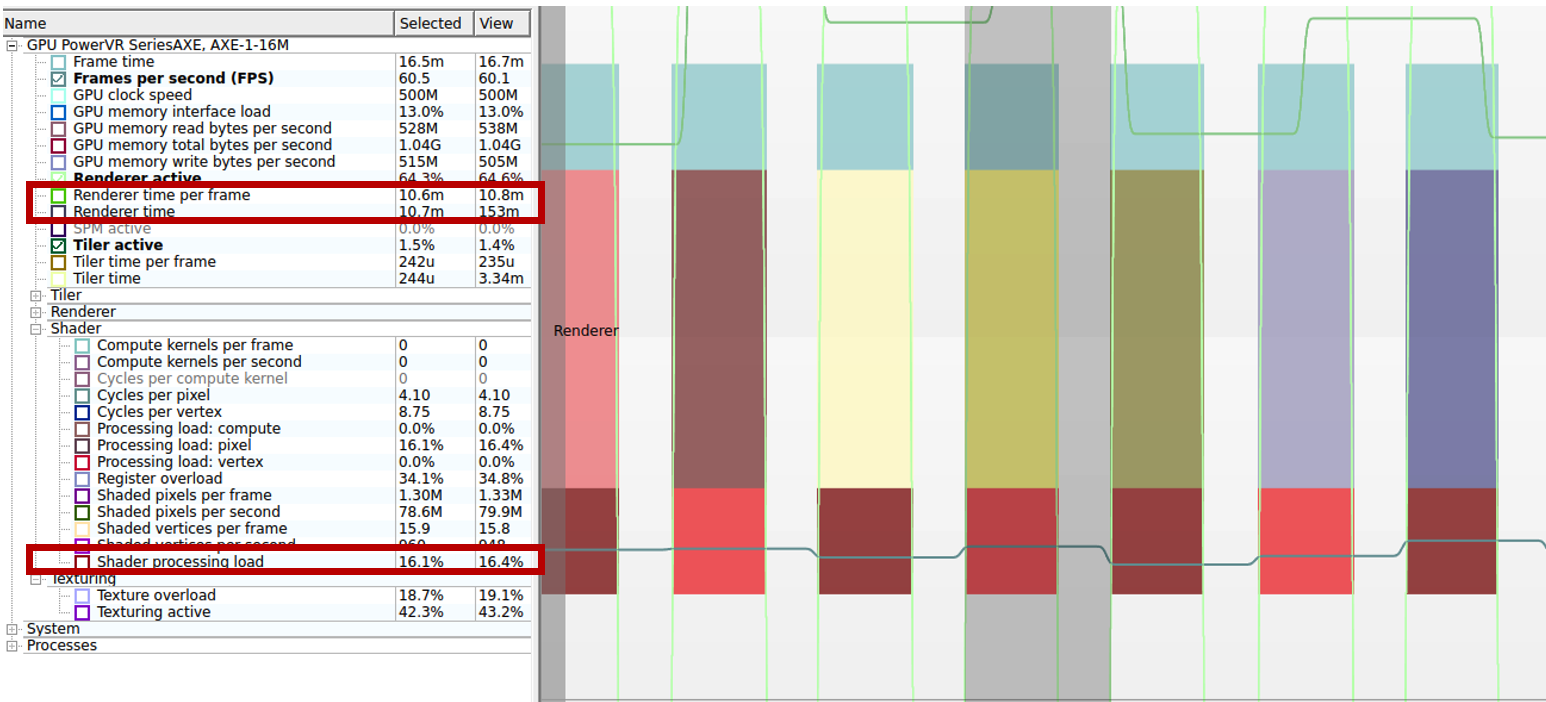SPRADC8 june 2023 AM625-Q1
- 1
- Abstract
- Trademarks
- 1Introduction
- 2Graphics Performance
- 3DSS Features
- 4Relevance of Functional Safety for Automotive Cluster Tell-tale Applications
- 5Safety Features on TI Sitara AM62x Processor
- 6Application-specific Task Partitioning and Safety Concept for Tell-tales
- 7 TI’s Functional Safety Offerings
- 8Summary
- 9References
2 Graphics Performance
In a standard digital cluster application, a screen inside a vehicle shows various information such as speed, tire rotations per minute, fuel percentage, tire pressure, engine faults, trip information, and more. The intent is to have modern graphics run inside a vehicle and display various system critical information. To run such rich graphical content, graphics performance is one of the most critical criteria for a digital cluster system.
The AM62x includes a 3D GPU core, the AXE-1-16M™, from Imagination Technologies. The 3D GPU core has the capability to draw eye-catching graphics inside a vehicle display. Figure 2-1 demonstrates how a GPU is used in a typical digital cluster application. There are various images for gauges, needles and backgrounds which are stored in memory. The GPU must read various images from memory and combine all the images to show critical statistics about the vehicle. In Figure 2-1, a cluster dashboard is shown using the GPU.
 Figure 2-1 Representative GPU
Rendering
Figure 2-1 Representative GPU
RenderingIn the use case shown in Figure 2-1, the GPU is used to perform the following operations:
- Read multiple images for the left and right dials.
- Read multiple images for the left and right needle.
- Scale images based on the output resolution.
- Rotate or transform the needles based on the acceleration or deceleration of the vehicle.
- Composite all components into a final image.
Once the GPU writes the final image to memory, the display controller reads the image and sends the image on a screen that is attached to the processor. On the AM62x, this use case is implemented a summary of the images is provided in Table 2-1.
| Input or Output | Resolution (Width × Height) |
Pixel Format |
|---|---|---|
| Standard Gauge PNG | 609 × 520 | ARGB8888 |
| Standard Needle PNG | 682 × 683 | |
| Display Framebuffer | 1920 × 1080 |
Based on the resolutions in Table 2-1, only 16% of the GPU compute power is utilized and the GPU is able to draw at 60 FPS. Many cluster applications have a strict requirement on updating the needles and dials at 60 FPS. The required performance is achieved with the AM62x processor.
The performance numbers from Table 2-1 are measured using the PVRTune tool from Imagination Technologies. The PVRTune tool is useful for capturing all the necessary GPU statistics while the GPU is being utilized. The PVRTune data for the AM62x cluster example is shown in Figure 2-2.
 Figure 2-2 Resource Utilization From
PVRTune
Figure 2-2 Resource Utilization From
PVRTuneVarious counters are displayed on the left side of Figure 2-2. The counters measure information such as FPS, GPU clock speed, total memory bandwidth consumed every frame, shader core utilized, and more. In the captured statistics, the GPU render time per frame is 10.6 ms and shader processing load is 16.1%. Based on the percentage load, there are still margins available for the GPU to render additional 3D scenes, such as navigation or media player. In most cases, designers prefer to select GPUs with higher processing power but depending on the use case or end-application such processing power is not even required. In summary, the AM62x processor can have less GFLOPS in comparison to other processors but has enough compute power to drive digital cluster applications.
In addition to running a custom OpenGL® ES® test, a Kanzi® Performance Analyzer (KPA) is also run on the AM62x platform. KPA is designed by Rightware® and the objective of KPA is to run a set of demanding tests based on automotive use cases. Upon running the tests, KPA outputs insightful reports and analysis for a given platform. The report generates a score that various original equipment manufacturers (OEMs) and Tier 1 suppliers can use to compare performance of the SoC. The AM62x score for the Fast Cluster KPA test, is provided in Table 2-2. In addition to the KPA, Altia® designed a more realistic digital cluster demonstration that runs on AM62x and the GPU renders 3D content at 60 FPS.
| Test | Resolution (Width × Height) |
Score |
|---|---|---|
| Fast Cluster | 1920 × 1080 | 244 |